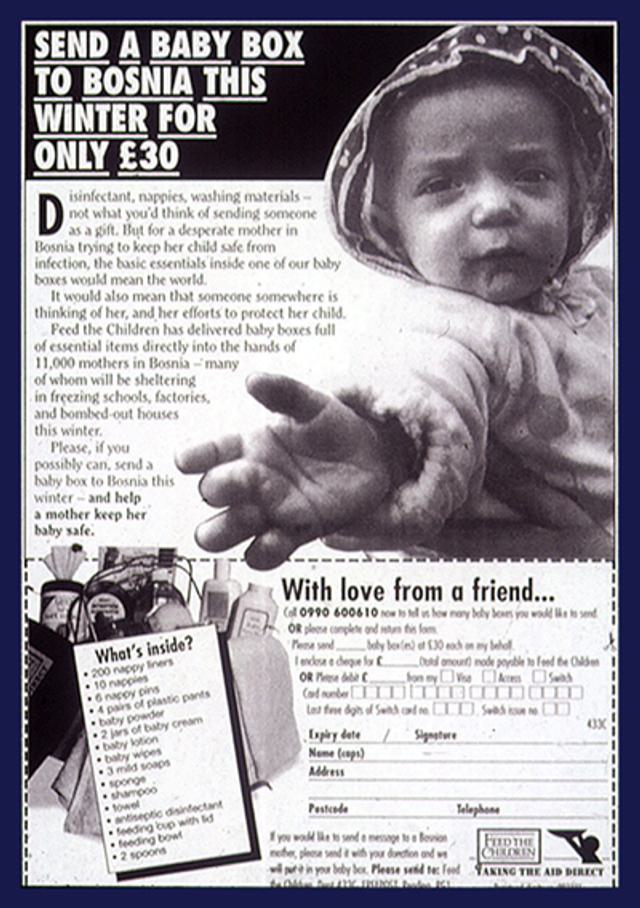Feed the Children’s ‘baby box’
- Exhibited by
- Burnett Associates Limited. Copywriter Karin Weatherup.
- Added
- September 03, 2009
- Medium of Communication
- Press advertising
- Target Audience
- Single gift
- Type of Charity
- Children, youth and family, poverty/social justice
- Country of Origin
- UK
- Date of first appearance
- Unknown
SOFII’s view
This is a story of classic product development. The baby box was devised specifically to respond to the need to maintain giving at a time when donor interest was flagging and the idea for it came from the best possible place – the charity workers on the front line. But the logic behind this initiative was unarguable and it proved to have lasting public appeal.
Summary / objectives
In the middle of the civil war in former Yugoslavia, after months of enterprising and very successful donor recruitment and development by Feed the Children UK (later renamed as Children’s Aid Direct) response levels, perhaps not surprisingly, began to fall off as donors became increasingly used to seeing images from the war zone on their nightly television broadcasts. Feed the Children’s agency, Burnett Associates, realised that they had to do something dramatic to revive interest in their client and its work. So they set about creating a new fundraising product, built around a classic ‘shopping list’ approach.
Background
In the mid 1990s, when the civil war at its height, aid agencies on the ground were allocated specific areas of responsibility and Feed the Children found itself charged with providing for mothers with young babies. At this time response to their sustained press recruitment campaign was beginning to show signs of serious tiredness, so Burnett Associates, with the support of FTC, sent one of its account managers to Bosnia to assess the situation. One of the field workers he met said ‘What each mother really needs here is a box containing just the basics of baby care – safety pins, nappies, cream, cotton wool and such like, the basic necessities of life that are in such short supply here.’ From this comment, the idea of the baby box grew.
Special characteristics
This is a medium value single gift product with opportunities for additional engagement and ongoing involvement.
Influence / impact
Many other charities particularly in the UK were looking at this time to recruit monthly donors. The success of the baby box product was frequently cited as an explanation for the number of monthly giving clubs and schemes that sprang up at this time.
Details
All media for FTC’s press advertisements at the time were continually and rigorously tested. The baby box offer out-performed the control by many times.
Results
Not specifically available, but they were spectacular and the cost of donor recruitment ‘off the page’ dropped significantly after the product appeared.
Merits
It’s a great, classic product that has massive donor appeal because it so clearly meets the most commonly asked donor question, ‘Where does my money go and what does it achieve?’
Other relevant information
These baby boxes were real. For each box bought by a donor a real box stuffed with necessities was delivered to a needy parent in Bosnia. In addition to the listed enclosures (see ad opposite) donors could also put in a special message, as an additional involvement device. Many did, including photographs, simple cards and often touching personal messages. Many Bosnian mothers replied to these, via the charity Feed the Children. These exchanges of goodwill messages were frequently covered in the national and local press, which brought in many new donors for FTC at no extra cost.
 View original image
View original image
 View original image
View original image
Also in Categories
Tags
- UK
















